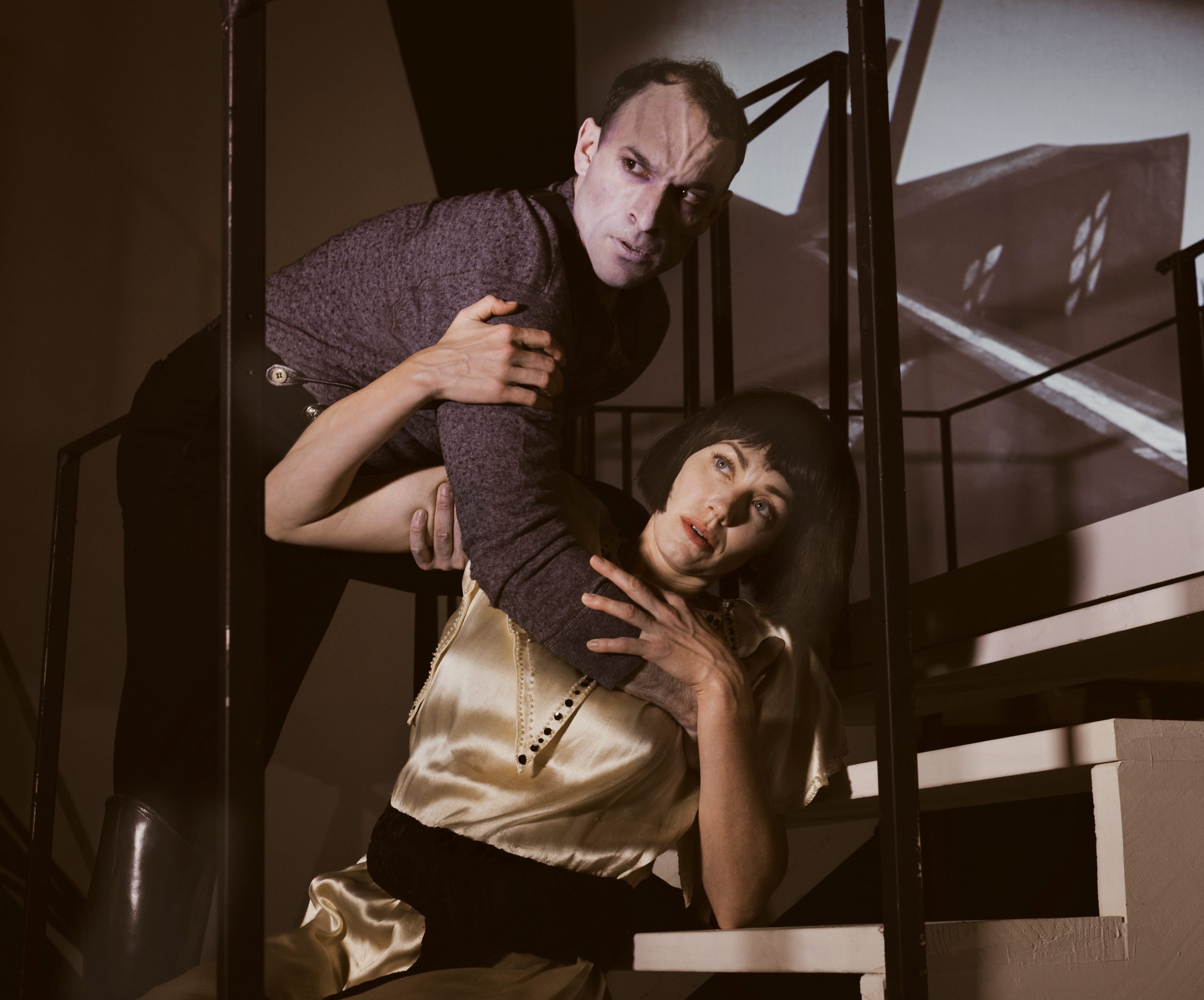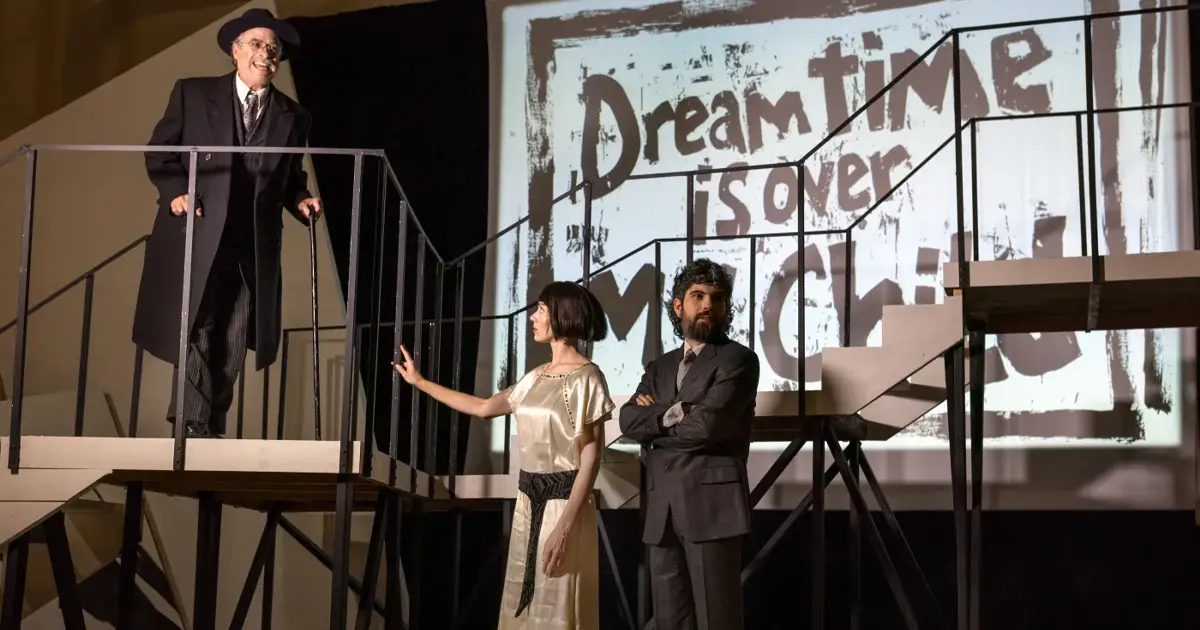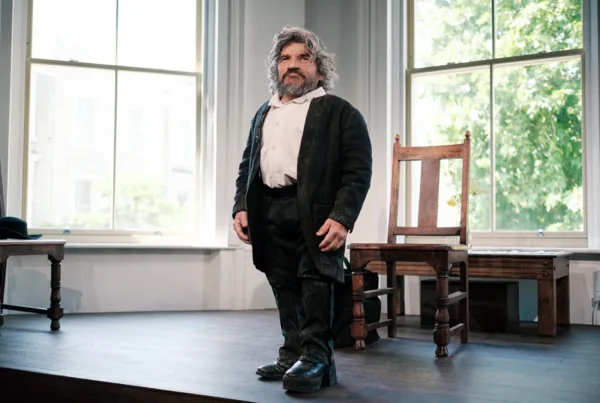
The Pittsburgh Tatler – At the beginning of my previous post I promised to write about two current productions that take a “theatrically inventive approach to very familiar material … [to] offer insights and provocations for our current troubling times.” That was Monday; since then, the times have become even more troubling, and the second of the productions – Quantum Theatre’s The Cabinet of Dr. Caligari – appears, in hindsight, far less hopeful than it did when I saw it.
Here the familiar material is the 1920 Expressionist film The Cabinet of Dr. Caligari, which tells the story of a mad doctor/ insane asylum director who uses hypnotism and drugs to manipulate Cesare, a shell-shocked WWI soldier, into killing people, among them the best friend of Franz, the film’s protagonist and narrator. In the film, that story – which many interpret as an allusion to the way young men are conscripted and manipulated into killing for their governments in war – is undercut by a framing device that reveals, in a twist ending, that Franz himself is actually a patient in an insane asylum who, in a delusional state, has projected evil intentions onto his (seemingly) benevolent psychologist, Dr. Caligari. The film’s ending is somewhat ambiguous, as it simultaneously restores faith in an authority figure and leaves open the possibility that Caligari is manipulating our perception of Franz’s sanity, just as Franz has described.
For his theatrical adaptation, playwright Jay Ball provides a different frame context to the core tale of horror, one that calls attention to the role artists play in waking us up when those in authority would prefer that we “sleepwalk.” Here the conceit is that a theatrical adaptation of the film is being developed and produced in 1970 by the East German Berliner Ensemble, under the artistic directorship of Helene Weigel (Catherine Gowl), widow of the company’s founder Bertolt Brecht (Mark August). The young members of the ensemble who are building the piece are enthusiastic about the potential of the material for their artistic/political work as an ensemble; the elderly Weigel, mentally sharp despite severe physical decline, is less confident that a play derived from a decadent Western film can serve to help build a socialist utopia. Nonetheless she allows them to show her what they’ve got.
In their version of the story, Franz (Nick Lehane) and his friends Hannah (Sara Lindsey) and Uli (Cameron Nickel) are freespirited, independent-minded artist-students who stumble upon Dr. Caligari’s (Daniel Krell) demonstration of his Somnambulist Cesare (Jerreme Rodriguez) at their town carnival fair. Caligari claims that Cesare can foretell the future, and when Uli asks to be told the date of his death, Cesare pronounces that he’ll be dead by morning. Cesare knows this because he is the one who will take Uli’s life, later that night. When the next day Franz and Hannah try to get to the bottom of Uli’s disappearance, they become ensnared in Caligari’s web of evil, and eventually both wind up drugged, hypnotized, and controlled by Caligari. Towards the end, when it’s revealed that Caligari has turned Franz into the next murderous Somnambulist, Ball steals a page from Brecht’s Threepenny Opera and sends in Weigel as a deus ex machina to write a better ending, because “tragedy teaches us that nothing ever changes.” It’s her ending that I alluded to in Monday’s post – she concludes the play by locking the authoritarian madman in a box – but on reflection the final image is, in fact, less hopeful than I initially thought: from within, Caligari is shaking the box, and you know that when he busts out he’ll be angrier and more threatening than ever.

L to R: Daniel Krell, Sara Lindsey, and Nick Lehane. Photo by Jason Snyder, courtesy Quantum Theatre.
Theatrical inventiveness here obtains on the level of both content and style. Director Jed Harris and the production’s design team have developed a distinctive aesthetic for this production that marries an Expressionist visual vocabulary to a post-dramatic approach to performance: the Brechtian and post-dramatic principles of creating theater that reminds you of its artifice are conspicuously evident. Yafei Hu’s set is an Escher-like configuration of stairs and platforms in black and white, with a large screen that is used both for shadow puppetry and for the projection of disorienting backgrounds reminiscent of the jagged landscapes of the original film. Angela Vesco’s black and white costumes ground the central story in Weimar Germany, a time when – like today – in-fighting on the left obstructed its capacity to resist the rise of fascism. C. Todd Brown’s lighting design creates deep contrasts of brightness and shadow on both the playing space and on the character’s faces, creating a spooky, horror-film vibe. Scenes begin abruptly with a sharp, loud bang of a drum – it’s as if the characters are sparked into life with the sound (designer: Joe Pino) – and are regularly interrupted by projected short films/commercials with titles like “Medicine under Capitalism” (projection design: Joe Seamans), which serve not only to critique capitalism for the fictive 1970 audience of the Berliner Ensemble, but also to connect the dots between consumerism and complacency for the real 2024 Quantum Theatre audience. Indeed, it may be these short films that offer the play’s most trenchant warning: that the real threat resides in a system that coopts and commercializes all resistance to it, turning rebels into sleepwalking consumers. It takes nothing less than an intervention from a couple of Zombie Communist artists – Weigel and Brecht, risen from the dead – insisting on the ideals of Socialism as a rebuttal to Capitalist “norming” to contain that threat (even if, it seems, only temporarily).




